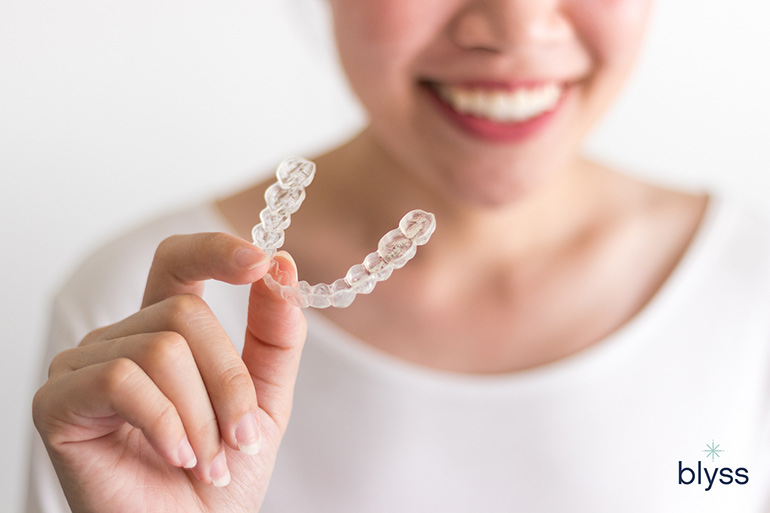If you’ve ever had a tooth knocked out or broken, you know how it can change your appearance and affect your confidence.
You search online for the best tooth replacement options, and you find the two most popular ones: dental bridges and dental implants.
But how do you know which one is right for you?
I know it can be confusing. But don’t worry! I’m here to help you determine which tooth replacement option is best for your personal situation.
What is the Difference Between A Dental Bridge and An Implant?
Tooth loss is actually more common than you think.
According to data from the American Association of Oral and Maxillofacial Surgeons, an overwhelming majority (69%) of adults aged 35–44 have experienced tooth loss due to accidents, gum disease, failed root canals, or dental decay.
This means many Americans are seeking tooth replacement options. On the top of the list of available options, you’ll find dental implants and dental bridges.
At their core, both implants and bridges are used to replace missing teeth.
However, there are some key differences between the two that you should be aware of before deciding which is best for your smile.
When you lose a tooth, the jawbone in the area begins to deteriorate, shrink, and change your facial appearance and smile over time. As per the American Academy of Implant Dentistry, a dental implant helps prevent this from happening.
A dental implant is a titanium post that is surgically placed into the jawbone to act as a replacement for a missing tooth root.
Implants help maintain bone structure and stimulate bone growth. It prevents other teeth from shifting out of place and provides a secure platform for a crown or prosthesis.
In contrast, a dental bridge is like a bridge over a river or a stream (Stewart & Bagby, 2020).
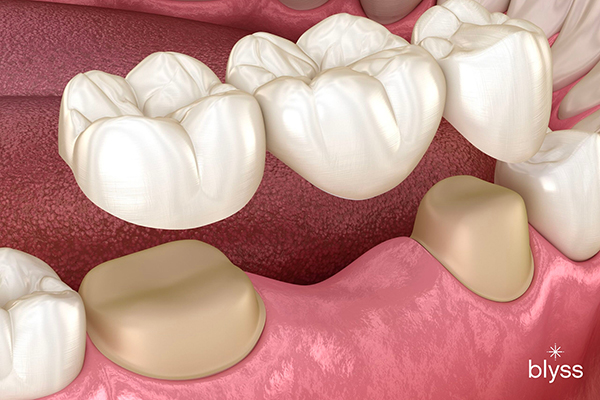
While bridges can help restore function and esthetics to your smile, they don’t necessarily prevent the jawbone from deteriorating or shrinking. They also require a specific flossing method to prevent gum disease and cavities.
It consists of a false tooth or teeth (pontic(s)) held in place by dental crowns (retainers) that have been cemented onto each of the natural teeth next to the missing tooth or teeth. Thus, a dental bridge “bridges” the gaps in your smile.
Consideration 1: Cost of Bridges vs. Implants
When it comes to replacing missing teeth, the cost can be a significant factor in your decision-making process.
Dental bridges are generally more affordable upfront than dental implants.
A dental bridge can cost about $1,000 to $2,500 per tooth. For example, a three-unit bridge is typically used to replace one tooth and may cost between $3,000 and $7,500.
On the other hand, dental implants and crowns typically cost between $3,000 and $7,000 per tooth in San Diego, California.
However, every patient and their specific treatment plan are unique. This means that every plan is customized according to the patient’s case, with several factors affecting the price.
The price is affected by the following factors:
- Type of bridge or implant
- Your dentist’s location
- Brand and material used
- Number of teeth that require replacement
- The complexity and severity of your case
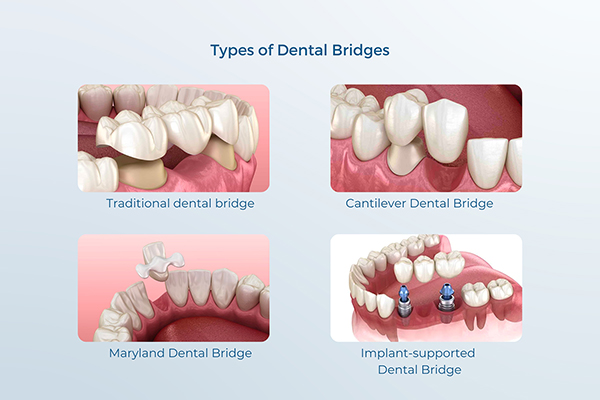
Dental bridges come in a variety of materials and designs, with each type affecting the cost of the procedure.
Does dental insurance cover both procedures?
Many dental insurance plans cover bridges, and many now cover implants as well. Dental insurance often covers up to 50% of these procedures, with the 40% to 50% range being the most common.
But take note that coverage can vary by provider and insurance plan. Additionally, some insurance plans have exclusions for pre-existing conditions and a waiting period of up to one year.
Avoid surprises and understand your insurance coverage by consulting with your provider. Before starting treatment, make sure you confirm maximum limits, copays, and deductibles.
Consideration 2: Time Needed for Each Procedure
Getting a dental implant takes several months. While getting a dental bridge only requires two to three visits to your dentist spread over a few weeks.
Dental implants may require multiple surgical procedures. This can include extraction, bone grafting, sinus lift, and the actual implant placement itself.
These surgeries may require several appointments over a six-month period. In some cases, such as an All-on-4 dental implant procedure, only one visit is needed for the surgery.
After surgery, there will be a waiting period for osseointegration, where the implant post “integrates” itself with your jawbone.
This period of healing and integration can take anywhere from 3–6 months before the final prosthesis can be placed on top of the implant.
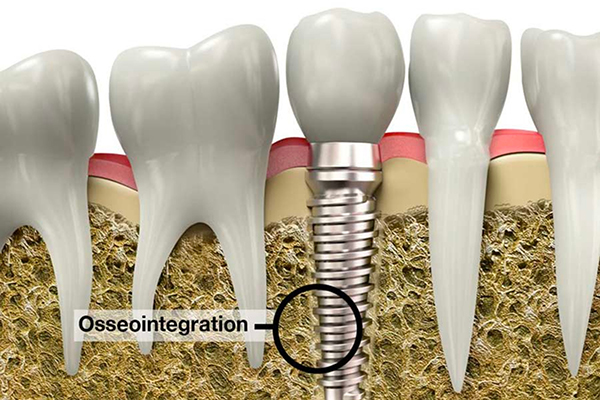
When osseointegration occurs, the dental implant will essentially become a part of the jawbone.
Note that the amount of time required to complete both bridges and implants varies. It is based on several factors that may affect healing time after treatment has been completed.
Ultimately, bridgework has the advantage in this category. It can typically be completed in two to three weeks, far less time than dental implants.
Consideration 3: Availability & Accessibility of Services
Bridges are generally more widely available than implants.
Traditional bridges require fewer materials than implants and can be completed in just two visits. And because it does not require surgery, more dentists offer dental bridge services than they do implant services.
Implants are not as widely available as bridges, but they provide a more permanent solution that suits certain cases.
Consideration 4: Bone Loss
When you lose a tooth, the underlying jawbone begins to shrink away due to a lack of stimulation from chewing or biting activities. This is known as “bone resorption” or “jawbone atrophy” of the jawbone.
Bone loss can change the look of your mouth and put pressure on your remaining teeth, causing them to shift. Without stimulation, the bone below your gum line will start to recede, causing a “sunken-in” appearance.
Dental bridges do not prevent jawbone loss. They only cover the gaps and sit above the gum line, meaning that the supporting bone may still get reabsorbed.
Bridges do not actually incorporate themselves into the jawbone, unlike implants. Thus, they provide little-to-no protection against bone loss after placement.
Meanwhile, dental implants offer much more stability because they are fused directly into the jawbone. They are the only replacement option for missing teeth that is designed to stimulate bone growth and prevent jawbone loss.
Consideration 5: Preserving Adjacent Teeth
There is a clear divide between dental bridges and dental implants when it comes to preserving adjacent teeth.
Dental bridges require the reduction of at least two adjacent teeth in order to support the crowns.
Dental implants, on the other hand, allow you to preserve adjacent teeth because they don’t rely on support from surrounding teeth.
Instead, they function as artificial “roots” that are secured in place by placing them straight into the jawbone. This offers a much more secure foundation for the prosthesis than is possible with a bridge.
Consideration 6: Durability
Bridges generally last 10 to 15 years with proper care and maintenance. Although they can last for 10 years or more, they may need to be replaced or adjusted over time due to everyday wear and tear.
On the other hand, studies show that implants can last up to 20 years and even longer with proper care.
The titanium posts themselves are meant to last a lifetime with proper hygiene and health. This makes them a longer-term solution than dental bridges. The posts are made with titanium, which is designed to withstand the test of time.

Dental implants are made of titanium, a durable, biocompatible metal known for its strength and longevity, making it a reliable solution for replacing missing teeth.
Implants clearly have a clear advantage when it comes to durability, as they last significantly longer with proper care.
Consideration 7: Risk Factors such as Infection or Rejection Issues
Both dental bridges and implants carry some risks in terms of risk factors like infection or rejection issues.
Risk of Rejection
Rejection differs between bridges and implants.
Body rejection of an implant doesn’t occur often, but it can happen. Studies show that 4.4% of all implant placements fail within the first 6 months post-surgery.
A number of factors can cause early implant failure, including:
- poor healing due to diabetes or smoking
- an inexperienced implant dentist
- insufficient jawbone
- poor oral hygiene
- gum disease
- allergic reaction
On the other hand, rejection issues are basically nonexistent with bridges. They do not involve any surgical implantation and instead rely on adjacent teeth for support.
Risk of Infection
There’s always a chance that bacteria could get trapped under the pontic of a dental bridge. This results in decay or gum disease over time.
Dental implants can also get infected if you don’t practice good oral hygiene.
Plaque buildup on top of an implant can still lead to infection over time if left unchecked, just like it can cause gum disease around natural teeth.
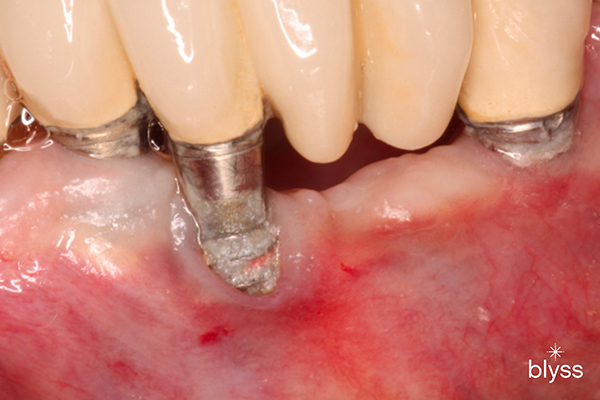
Image caption: Plaque buildup on dental implants can cause gum disease if not properly removed, leading to pain and long-term damage to the gums and teeth.
Consideration 8: Maintenance
| Dental Bridges | Dental Implants | |
|---|---|---|
| Cost | $1,000 - $2,500 (per tooth with crown) For ex., a three-unit bridge may cost between $3,000 and $7,500. | $3,000 - $7,000 (per tooth with crown) |
| Dental Insurance Coverage | Yes, most providers cover bridges | Yes, some providers cover implants |
| Length of Treatment Time | 2-3 weeks | 3-6 months |
| Availability and Accessibility | Widely available | Not necessarily as readily available |
| Durability | 10-15 years | 15-20 years |
| Risk of Tooth Decay | There is a risk of tooth decay. | There is no risk of tooth decay. |
| Maintenance | Requires a special floss or water for cleaning under the pontic | No special cleaning methods or maintenance are required. |
Dental bridges require more stringent cleaning since food can get stuck under the pontic and adjacent teeth.
Cleaning the pontic also requires you to use a special floss, such as a floss threader, super floss, or water flosser.
When brushing and flossing, I always tell my patients to pay special attention to areas where food may accumulate. Failure to do so may cause plaque buildup.
I also recommend professional cleaning every six months to maintain a healthy smile if you have a dental bridge.
On the other hand, dental implants do not have special maintenance requirements. You can brush and floss implants in the same way you would take care of your natural teeth. Also, make sure you get professional cleaning every six months when you have dental implants.
The best thing about dental implants? When properly cared for, dental implants outlast all other tooth replacement options.
The Final Decision: Bridges or Implants?
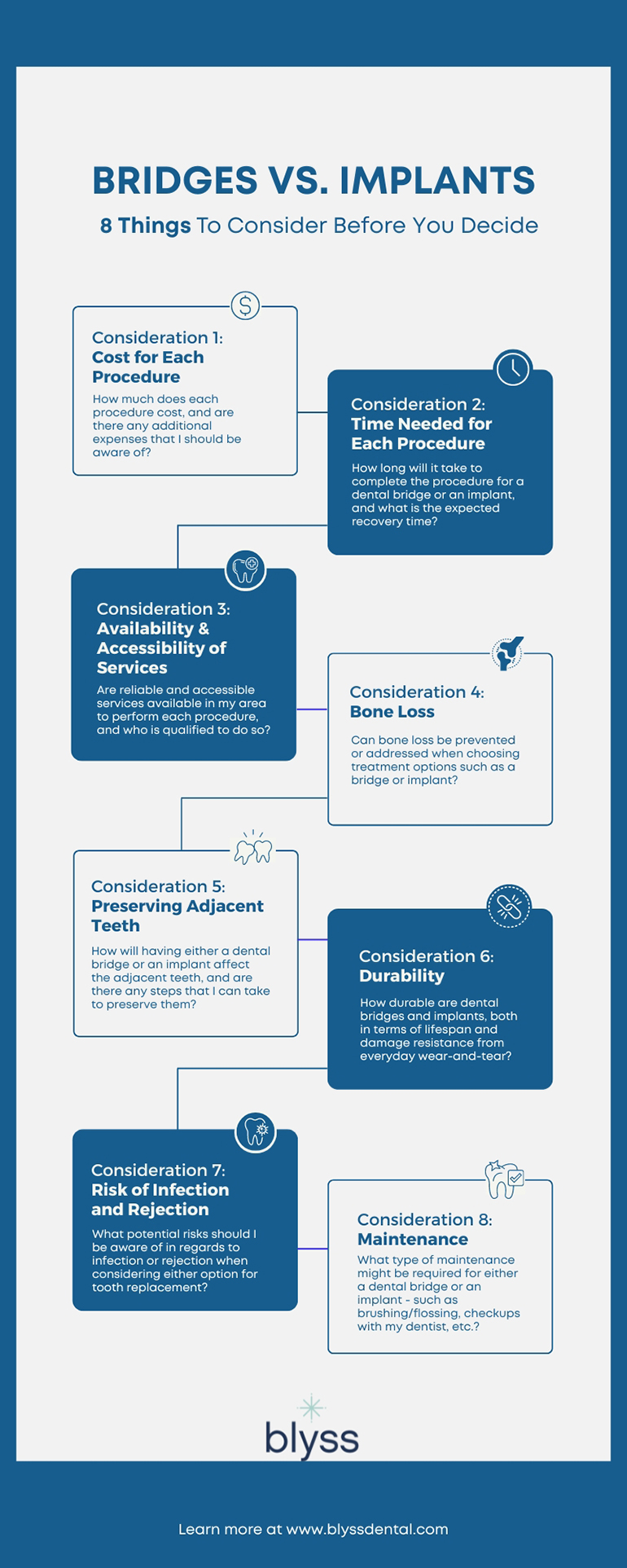
Consider these eight factors before settling between dental bridges and dental implants.
Ultimately, there is no “right” choice when it comes down to selecting either a bridge or an implant. Both are viable options, depending on your particular needs.
An implant is your best bet if you want something that looks more natural and will last long.
In contrast, a bridge could provide similar results at lower immediate costs. However, it may require more maintenance in the long term because it relies on the surrounding teeth to support it properly.
Though it may seem like a daunting decision, there is no need to worry about picking the “wrong” dental treatment.
Both implants and bridges are great choices that can restore your smile after tooth loss. It just depends on what will work better for you.
The best way to figure out which option is ideal in your case is by booking a free consultation at Blyss Dental. That way, I can give you expert advice, and I will be able to help you make the right choice.
Contact us today to schedule your appointment!
Sources Cited From
- Stewart, M., & Bagby, M. (2020). Clinical Aspects of Dental Materials. Jones & Bartlett Learning.
- Dental Assistants’ Association of Australia, Barnett, L. V., & Dental Assistants’ Association of Australia. (2004). The Manual of Dental Assisting. Elsevier Gezondheidszorg.
- Dental Implant Procedures. (2022, March 4). American Academy of Periodontology. https://www.perio.org/
for-patients/ periodontal-treatments-and-procedures/ dental-implant-procedures/ - AAID Credentialed Dentists. (2022, February 10). Frequently Asked Questions – The Dental Implant Experts – AAID-Credentialed Dentists. The Dental Implant Experts. https://www.aaid-implant.org/
faqs/ - AAID Credentialed Dentists. (2022b, August 15). AAID Implants Home. The Dental Implant Experts. https://www.aaid-implant.org/
- AAID Credentialed Dentists. (2021, August 12). What are Dental Implants? – The Dental Implant Experts – AAID-Credentialed Dentists. The Dental Implant Experts. https://www.aaid-implant.org/
what-are-dental-implants/


